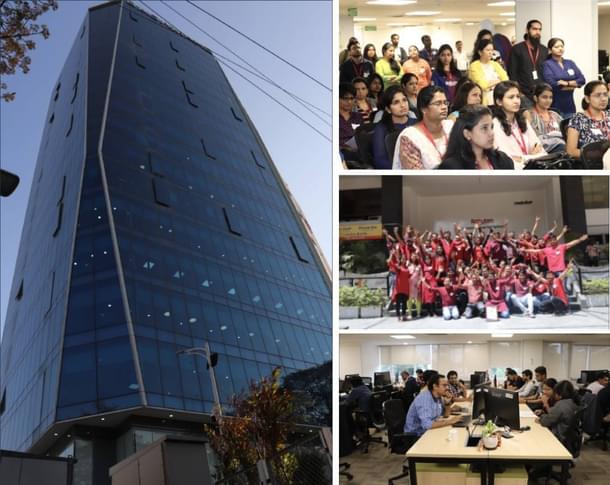Technology
Our Brains, Their Business: Why The World’s Biggest Enterprises Are Making A Beeline To India To Set Up Global Capability Centres
Anand Parthasarathy
Feb 22, 2023, 05:44 PM | Updated 05:44 PM IST
Save & read from anywhere!
Bookmark stories for easy access on any device or the Swarajya app.


Earlier this month, the American consumer credit reporting company TransUnion, better known for its CIBIL ratings, opened a new Global Capability Centre (GCC) in Pune, expanding its local innovation team to 600 and adding to its India strength of engineers also based in Bengaluru and Hyderabad to over 3,000.
"India’s strong digital skills and infrastructure support a compelling growth and expansion opportunity for TransUnion,” said TransUnion's Executive Vice President for Global Operations, Eric Hess

Only weeks before the Pune opening, the world’s largest electronics component mark, Digi-Key, launched the first overseas GCC, outside its Minnesota, US headquarters, in Bengaluru, to “serve as an epicenter for technology and innovation for Digi-Key’s operations globally”.
In mid-2022, one of the largest players in the automotive aftermarket parts industry, Raleigh, North Carolina, US-based Advance Auto Parts, chose Hyderabad for its GCC which was planned as “as a hub of innovation, providing critical transformational support and automotive solutions across IT, Digital, Finance, and Human Resources, for its North American markets”.
Also in 2022, the Japanese product engineering company Rakuten opens its biggest overseas facility in Bengaluru — a 20-storeyed facility with room for 3,000 employees who are working on deep-tech innovation and R&D in areas such as e-commerce, fintech, content and entertainment, as well as AI in computer vision, speech, and natural language processing (NLP).

India is a favoured location for GCCs, found a study by National Association of Software and Service Companies (NASSCOM) with ANSR; a market leader in helping international players design, establish and operate their global captive centres of innovation.
It predicted in 2020 that over 80 percent of the top global retail and consumer packaged goods companies will look to India for setting up a GCC.
It is happening.
An updated report on India GCC Trends by NASSCOM, with Zinnov; the India-based consultancy which for over two decades has helped international companies set up technology centres in India — attests to the pace at which international players, mostly in the technology sector have been pitching their R&D tents in India — 15 GCCs in the third quarter alone, 9 of them in the software and Internet space including biggies like International Business Machines (IBM) and Thoughtworks.
The report calls the size of the India GCC market “staggering” at $36 billion, and likely to hit $60-85 billion within three years. There are over 1,500 GCCs in India today, a talent pool of 1.38 million. Almost 85 per cent of all GCCS are located in Bengaluru which remains the most favoured location, followed by Mumbai, Delhi/National Capital Region and Hyderabad.
Beyond Cost And Labour Arbitrage
Some things, however, have changed since the first decade of this century (2000- 2010) when the idea of captive MNC R&D centres (as GCCs were then known) in India, was first translated into reality.
Then and now, these were client owned and operated service delivery centres, typically in low-cost locations, providing services and resources directly to the parent company. But while the definition has not changed, the motivation has.
In its formative decade India-based GCCs were driven by a simple financial motive: labour arbitrage. If the cost of technical expertise was high in a company’s home, move the activity to a location where such labour was cheap and pocket the difference.
Qualified technical personnel could be had very cheaply in India compared to the US, West Europe and Japan. Productivity was the name of the game.
Today GCCs in India have moved up the value chain to become what tech consultants EY (formerly Ernst & Young) call “multifunction globally integrated centres of excellence”.
Ramkumar Ramamoorthy, former Managing Director of Cognizant India and currently a technology adviser with Catalincs in a recent opinion piece in Times of India said, “The cliché that foreign MNCs come to India for cost, stayed on for quality and expand for innovation is no longer applicable".
"Today, these companies establish their GCCs in India to digitally transform their businesses, better compete against new-age startups, drive research on newer technologies, and develop pathbreaking solutions, products, platforms, and IP for global consumption,” he added.
In other words, the innovations delivered by Indian GCCs are not just cost-savings but core to the parent company’s competitive edge.
Unmatched Talent Pool
And central to the India success story — with a near 50 per cent share of the global GCC market — is its unmatched talent pool of one million engineers graduating every year, one of the largest engineering talent pools in the world.
Workforce solutions provider, Next Level Business (NLB) Services, recently released what it called the India Captivating Report, covering the GCC ecosystem from the lens of manpower and recruitment.
It found that 78 per cent of GCCs come to India to augment or create a superior talent pool. About 3.64 lakh jobs will be created by GCCs this year alone.
“The demand today is for niche digital and machine learning skills like data science, data analytics, data engineering, statistical analysis, and UI/UX design indicating how the centres are evolving to strategic centres,” says Varun Sachdeva, APAC Recruitment and Business Leader, NLB Services.
And what is the top-rated skill for such centres today? Big Data Analytics Manager, with a payout of Rs 20 lakh per annum is the top job role GCCs are hiring for, finds the NLB study.
What do MNCs hope to achieve with this talent? K S Viswanathan, Vice President of industry initiatives at NASSCOM says “We are in the third generation of GCCs in India. The first was about productivity, then about building enterprise capabilities, and the third piece now is on transformation work focused on the middle and front office".
Some Taxation Irritants
The revenue generated by India-based GCCs already accounts for about one per cent of the national gross domestic product (GDP), and this is seen to rise to two-three per cent within three years.
However, there are some glitches in India’s taxation regime (determining the price for trading in goods or services between related enterprises) that need to be ironed out, said many GCC leaders, quoted in Financial Express; when they shared their pre-budget wish-list.
Indications are this has not happened and experts have suggested that India’s transfer pricing policy needs to be “much simpler, predictable and friendlier, if the full potential of GCCs is to be realised”.
While India has provided a perfect and sustainable launchpad for GCCs that leverage quality talent and capabilities in the country, GCCs have also contributed significantly in return to India, suggests a 2021 study by Deloitte for NASSCOM titled GCC: The value proposition for India.
To get these returns, however, companies must invest in skilling their manpower in cutting edge technologies. ANSR spoke to the people who should know best, the leaders of India GCCs.
In a compilation (registration needed) of their views, entitled “GCC leaders’ tech predictions for 2023” released two weeks ago, they advised “To prepare for the unexpected and adapt to whatever 2023 holds, future-ready organizations will make wise technology investments that secure future growth".
"2023 will see AI adoption skyrocket by the rapid diffusion of models into all kinds of applications. Blockchain, Augmented or Virtual Reality (AR/VR), Web3, and Metaverse technologies are set to take center-stage as well,” they added.

Real Estate Demands
Beyond the obvious employment potential, GCCs have helped create a booming market for office space. A recent report (registration required) from global real estate leaders Cushman and Wakefield Global Capability Centre: Powering the Growth of Indian Commercial Real Estate highlights “Growth of GCCs has big implications for the commercial real estate sector".
It suggests "Nearly a quarter of Grade A office stock across top-8 real estate markets in India is currently occupied by GCCs, and future office demand is expected to be fuelled by more GCCs trying to establish presence across its major cities. Going beyond, some tier-II cities are also expected to witness traction from GCCs in near future as has been expressed by many GCC tenants in India in the recent past”.
Looking beyond the potential for real estate, the report highlights the larger canvas where GCCs are providing India a critical edge:
“The growth of GCCs in India has been encouraging on 2 fronts:
India has been successful in catering to the boom in new age fields like Machine Learning, Artificial Intelligence, Robotics among others and service the demand globallyIndia’s current advantageous position in the IT outsourcing space is getting a boost as gradually the low-cost outsourcing model is being replaced by a more value-added outsourcing model”.
Its conclusion serves as a succinct summary of the promise and potential of global centres of innovation in India, which after business process outsourcing (BPO), Year 2000 software (Y2K) , contact/call centres and product engineering services, offer, arguably, the most valuable new technology-driven business opportunity for India:
“The primary driver for the growth of GCC in India is the economy’s rising global competitiveness in critical areas such as availability of large tech talent at a competitive cost, significant improvement in digital infrastructure, a flourishing start-up ecosystem and the rising entrepreneurial spirit”.
Anand Parthasarathy is managing director at Online India Tech Pvt Ltd and a veteran IT journalist who has written about the Indian technology landscape for more than 15 years for The Hindu.




